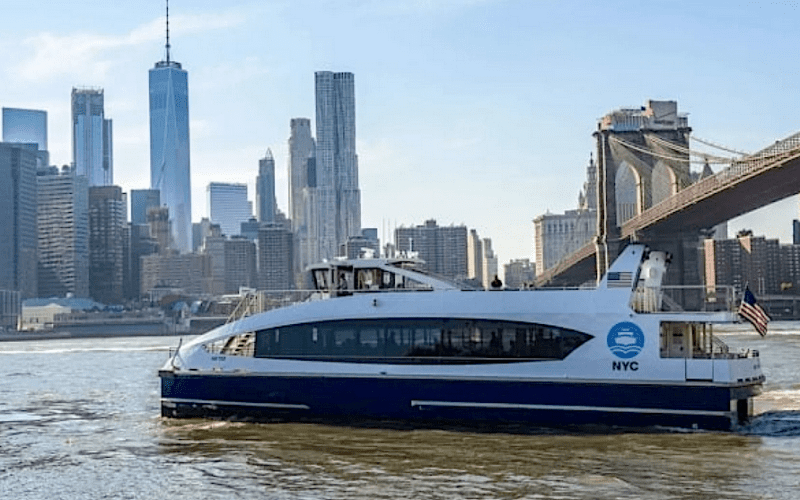(NEW YORK) — Staten Island Ferry and NYC Ferry will begin testing the use of renewable diesel fuel, a petroleum-free alternative to traditional diesel fuel. Renewable diesel reduces carbon emissions by 60 percent or more and its use in the ferries will help nearly 30 million annual riders navigate the city’s waterways in a more sustainable way.
NYC Ferry will also launch a short-term plan to upgrade engines on its largest vessels to reduce emissions and other pollutants. Use of the fuel in select Staten Island Ferry and NYC Ferry vessels builds on the city’s recent announcement that 100 percent of its 12,500 heavy-duty and off-road vehicles have completed the transition to renewable diesel, making New York the first major East Coast city to implement this green technology at such a large scale.
“As New Yorkers, we understand the urgent need to combat climate change, and today’s announcement is another critical step forward in that fight. In utilizing renewable diesel for our ferry fleets, we are demonstrating our commitment to reducing harmful emissions and reaffirming our commitment to making every corner – and current – of our city healthier and more sustainable,” First Deputy Mayor Maria Torres-Springer said Monday. “Whether it’s through innovative technologies or bold investments in green infrastructure, we are building a cleaner, greener New York City for all our residents – one that prioritizes our environment, enhances quality of life, and sets an example for cities around the world.”

“The Staten Island Ferry is the busiest municipal ferry service in the country, and we are thrilled to reduce its carbon footprint by using a petroleum-free alternative to traditional diesel fuel,” said Commissioner Ydanis Rodriguez of the New York City Department of Transportation (NYC DOT). “The transportation sector is responsible for nearly 28 percent of greenhouse gas emissions in our city, but that means it can also be a key part of the solution. Reducing dependence on fossil fuels offers a key step towards a greener and healthier New York City.”
Staten Island Ferry renewable diesel transition
NYC DOT is now testing the use of renewable diesel on the Marchi Staten Island Ferry boat. The renewable fuel serves as a direct replacement to ultra low sulfur diesel currently used in the ferry fleet. The agency plans to expand renewable diesel to the full Staten Island Ferry fleet in 2025. With an estimated 60 percent reduction in the Staten Island Ferry’s carbon dioxide (CO2) emissions, this move is critical to achieving a 50 percent reduction in these emissions by 2030.
Staten Island Ferry is the busiest municipal ferry service in the country, with approximately 45,000 passengers on an average weekday, carrying nearly 24 million passengers each year. It operates 24 hours per day, 365 days per year, between Staten Island and Lower Manhattan. Staten Island Ferry emissions represent 15 percent of municipal government transportation emissions, and emissions from fuel use for ferry vessels represent 94 percent of the Staten Island Ferry system’s greenhouse gas emissions.
NYC Ferry renewable diesel pilot and immediate vessel upgrades
The New York City Economic Development Corp. (NYCEDC) and NYC Ferry will launch a six-month pilot program of renewable diesel fuels on select vessels. Following a successful pilot, the goal will be to transition the entire fleet to renewable diesel in 2025. Additionally, NYCEDC and NYC Ferry will begin the process of upgrading 13 350-passenger vessels, the system’s largest vessels, to meet the U.S. Environmental Protection Agency’s most stringent Tier 4 emission standards. These conversations will reduce pollutants like nitrogen oxides (NOx) and particulate matter (PM) by up to 65 percent.
These immediate upgrades will be part of a broader sustainability strategy that will aim to transition the NYC Ferry fleet toward zero- and reduced-emissions vessels. As part of this strategy, NYCEDC will begin a study focusing on both the vessels and changes to shoreside infrastructure necessary to support their operation. NYCEDC anticipates this study concluding in late 2025. It will provide valuable insight into facilities and vessel operators throughout the harbor, and also serve as a valuable tool to attract increased grant assistance.
The NYC Ferry system provides more than 7 million riders annually with safe, dependable, affordable and accessible transit across the five boroughs. With six routes that touch every borough, 25 landings, and 38 vessels, the system spans 70 nautical miles and has the largest passenger-only fleet in the nation. NYC Ferry has further proven to be among New York City’s most resilient transit network with the fastest ridership recovery of any city transit system since the pandemic.
The city supply of renewable diesel has been sourced mostly (98 percent) from waste animal fats and used cooking oil. The transition will prevent 162 million pounds of global carbon dioxide emissions from entering the air every year, and it will serve as an important bridge fuel as viable electric versions of these vehicles are developed and placed into the market.
– New York City Economic Development Corp.

